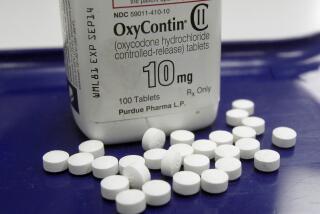Capping years of criticism, Purdue Pharma will stop promoting its opioid drugs to doctors
- Share via
The manufacturer of the powerful painkiller OxyContin announced this week that it will stop promoting its opioid drugs to doctors after years of criticism and mounting lawsuits, some based in part on a Times investigation.
Connecticut-based Purdue Pharma informed its employees that it was cutting its sales force in half, leaving about 200 representatives in the U.S., who no longer will visit doctors’ offices to discuss the company’s opioid products.
“We have restructured and significantly reduced our commercial operation and will no longer be promoting opioids to prescribers,” the company said in a statement. “Going forward, questions and requests for information about our opioid products will be handled through direct communications with … our medical affairs department.”
The company is facing dozens of lawsuits from cities across the country prompted in part by Times reporting that revealed Purdue had extensive evidence pointing to illegal trafficking of its pills but in many cases did not share it with local law enforcement agencies or cut off the flow of the drugs. The plaintiffs are seeking to hold the company financially responsible for a raging opioid epidemic.
Brandeis University researcher Dr. Andrew Kolodny, a longtime critic of the pharmaceutical industry’s role in the opioid epidemic, welcomed Purdue’s announcement but said, “It’s pretty late in the game to have a major impact.”
“The genie is already out of the bottle,” Kolodny said. “Millions of Americans are now opioid-addicted because the campaign that Purdue and other opioid manufacturers used to increase prescribing worked well. And as the prescribing went up, it led to a severe epidemic of opioid addiction.”
One Los Angeles ring tracked by Purdue and highlighted by The Times investigation supplied large quantities of OxyContin to gang members and other criminals who trafficked the drug to a Crips leader in Everett, Wash., from 2008 to 2010. That dealer sold the highly addictive pills to low-level dealers, who blanketed the entire region.
Many addicts later switched to heroin, a cheaper opioid.
Attorneys for the drug manufacturer have argued that plaintiffs who have sued the company suffer from a number of legal failings — including statute-of-limitations problems and a failure to demonstrate a close connection between the company’s conduct and the criminal acts of drug dealers and addicts.
“[T]here is no basis in law for a municipality to bring such an action against a pharmaceutical manufacturer,” Purdue’s lawyers wrote in the case brought by Everett, a city of 100,000 north of Seattle.
In an attempt to stem the abuse of OxyContin, Purdue spent a decade and several hundred million dollars developing a version of the painkiller that was more difficult to snort, smoke or inject. Since those “abuse-deterrent” pills debuted seven years ago, misuse of OxyContin has fallen and the company has touted them as proof of its efforts to end the opioid epidemic.
But a study released in January 2017 found that rather than curtail deaths, the change in OxyContin contributed heavily to a surge in heroin overdoses across the country and that, as a result, there was “no net reduction in overall overdose deaths.”
Experts have long blamed skyrocketing heroin use on painkiller addicts transitioning to the cheaper, more easily available street opioid. But the study by scientists at the University of Pennsylvania and Rand Corp. was the first large-scale research to tie the alarming growth in heroin deaths to Purdue’s introduction of its new pills.
More than 7 million Americans are estimated to have abused OxyContin since its 1996 debut. The researchers from Penn’s Wharton School and Rand analyzed levels of OxyContin abuse on a state-by-state basis in the years leading up to the pill reformulation and then looked at deaths from heroin in a three-year period after the change. They found that heroin deaths more than tripled — from 3,000 in 2010 to 10,500 in 2014. And states where OxyContin abuse rates were the highest “experienced the largest increases in heroin deaths,” the authors wrote.
Washington University School of Medicine professor Theodore J. Cicero, who separately has studied the role that OxyContin reformulation played in heroin addiction, said he found the Penn-Rand study credible.
Though the marketing of opioids directly to doctors has received a lot of attention, there are other ways drugmakers influence which drugs get prescribed, said University of North Carolina researcher Nabarun Dasgupta, who has advised federal health authorities and the World Health Organization on prescription opioid abuse.
Pharmaceutical companies often conduct studies in the hopes they can convince a health insurance company or Medicaid that their product is superior, he said. A drugmaker can negotiate with an insurer to give preferential reimbursement for its drug but require prior authorization for competitors’ drugs, Dasgupta said.
“Doctors are not robots — they are part of a system that influences their behavior,” he said. “It’s those structural incentives to prescribe one drug over another that are more arcane and more hidden and don’t generate the same level of public alarm.”
One remaining question is whether other opioid makers will follow suit and cease marketing the drugs to doctors, said Kolodny, executive director and co-founder of Physicians for Responsible Opioid Prescribing.
“We would have more success in encouraging cautious prescribing if drug companies stopped promoting aggressive prescribing,” he said.
It’s also unknown if Purdue will continue marketing the drug to doctors outside the United States through its international arm, known as Mundipharma.
Spokesman Bob Josephson said that Purdue is an independent company operating in the U.S. and that “the other companies operate under different leadership structures, within distinct regulatory environments.”
A Mundipharma representative did not immediately respond to a request for comment Saturday.
Kolodny said Mundipharma is using the same playbook abroad that Purdue used in this country to increase prescriptions.
“If it takes off the way it did in the United States, these other countries will be dealing with the same problem we are dealing with today,” he said.
Purdue was a small New York City pharmaceutical firm when brothers Mortimer and Raymond Sackler, both psychiatrists, bought it in 1952. The spectacular success of OxyContin has generated tens of billions of dollars in revenue over the last two decades and made the Sacklers one of the nation’s wealthiest families. Three generations of the family now help oversee the Purdue and Mundipharma corporations.
The family is known for giving tens of millions of dollars through its foundations to such renowned arts institutions as the Victoria and Albert Museum in London, the Dia Art Foundation and the Solomon R. Guggenheim Museum in New York.
In the January edition of Artforum magazine, celebrated photographer Nan Goldin wrote an essay about her addiction to OxyContin, which she was taking for a wrist injury. Now clean, she wrote about the advocacy group P.A.I.N., Prescription Addiction Intervention Now, that she started to push for the Sackler family and their drug company to pay for treatment and education programs.
“The Sackler family and their private company, Purdue Pharma, built their empire with the lives of hundreds of thousands,” Goldin wrote.
UPDATES:
7:00 p.m.: This article was updated with more information about the Sackler family.
5:45 p.m.: This article was updated with new information from Purdue Pharma.
4:10 p.m.: This article was updated with comments from a University of North Carolina researcher who has advised federal health authorities on prescription opioid abuse.
1:20 p.m.: This article was updated with new comments from activists and critics of the drug maker.
12:40 a.m.: This article was updated throughout with staff reporting, including new information from Purdue Pharma and more historical background.
This article was originally published at 11 a.m.
More to Read
Sign up for Essential California
The most important California stories and recommendations in your inbox every morning.
You may occasionally receive promotional content from the Los Angeles Times.














